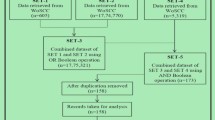Abstract
This paper presents the results of the analysis of keywords used in Social Network Analysis (SNA) articles included in the WoS database and main SNA journals, from 1970 to 2018. 32,409 keywords were obtained from 70,792 works with complete descriptions. We provide a list of the most used keywords and show subgroups of keywords which are connected to each other. To go deeper, we place the keywords into the contexts of selected groups of authors and journals. We use temporal analysis to get an insight into some keyword usage. The distributions of the number of keyword types and tokens over time show fast growth starting from 2010s, which is the result of the growth in the number of articles on SNA topics and applications of SNA in various scientific fields. Even though the most frequently used keywords are trivial or general, the approaches used for the normalization of network link weights allow us to extract keywords representing substantive topics and methodological issues in SNA.







Similar content being viewed by others
References
Batagelj, V. (2014). Nets—Python package for network analysis. Available at: https://github.com/bavla/Nets/tree/master/source.
Batagelj, V. (2017). WoS2Pajek. Networks from Web of Science. Version 1.5 (2017). Available at: http://vladowiki.fmf.uni-lj.si/doku.php?id=pajek:wos2pajek.
Batagelj, V. (2019). On fractional approach to analysis of linked networks. Available at: arxiv:1903.00605.
Batagelj, V., & Maltseva, D. (2020). Temporal bibliographic networks. Journal of Informetrics. https://doi.org/10.1016/j.joi.2020.101006
Batagelj, V., & Cerinšek, M. (2013). On bibliographic networks. Scientometrics, 96(3), 845–864.
Batagelj, V., Doreian, P., Ferligoj, A., & Kejžar, N. (2014). Understanding large temporal networks and spatial networks: Exploration, pattern searching, visualization and network evolution. Chichester: Wiley.
Batagelj, V., Ferligoj, A., & Doreian, P. (2020). Bibliometric analysis of the network clustering literature. In P. Doreian, V. Batagelj, & A. Ferligoj (Eds.), Advances in network clustering and blockmodeling (pp. 63–102). Hoboken, NJ: Wiley.
Batagelj, V., Ferligoj, A., & Squazzoni, F. (2017). The emergence of a field: A network analysis of research on peer review. Scientometrics, 113, 503–532.
Batagelj, V., & Praprotnik, S. (2016). An algebraic approach to temporal network analysis based on temporal quantities. Social Network Analysis and Mining, 6(1), 1–22.
Bonacich, P. (2004). The invasion of the physicists. Social Networks, 26, 285–288.
Borgatti, S. P., & Foster, P. C. (2003). The network paradigm in organizational research: A review and typology. Journal of Management, 29(6), 991–1013.
Brandes, U., & Pich, C. (2011). Explorative visualization of citation patterns in social network research. Journal of Social Structure, 12(8), 1–19.
Freeman, L. C. (2004). The development of social network analysis. A study in the sociology of science. Vancouver, BC: Empirical Press.
Freeman, L. C. (2011). The development of social network analysis-with an emphasis on recent events. The SAGE Handbook of Social Network Analysis, 21(3), 26–39.
Gauffriau, M., Larsen, P., Maye, I., Roulin-Perriard, A., & von Ins, M. (2007). Publication, cooperation and productivity measures in scientific research. Scientometrics, 73(2), 175–214.
Hummon, N. P., & Carley, K. (1993). Social networks as normal science. Social Networks, 15(1), 71–106.
Hummon, N. P., Doreian, P., & Freeman, L. C. (1990). Analyzing the structure of the centrality-productivity literature created between 1948 and 1979. Science Communication, 11(4), 459–480.
Kejžar, N., Černe, S. K., & Batagelj, V. (2010). Network analysis of works on clustering and classification from web of science. Classification as a tool for research (pp. 525–536). Berlin, Heidelberg: Springer.
Lazer, D., Mergel, I., & Friedman, A. (2009). Co-citation of prominent social network articles in sociology journals: The evolving canon. Connections, 29(1), 43–64.
Leydesdorff, L., Schank, T., Scharnhorst, A., & De Nooy, W. (2008). Animating the development of Social networks over time using a dynamic extension of multidimensional scaling. El Profesional de Informacion. https://doi.org/10.3145/epi.2008.nov.04.
Maltseva, D., & Batagelj, V. (2019). Social network analysis as a field of invasions: Bibliographic approach to study SNA development. Scientometrics, 121(2), 1085–1128. https://doi.org/10.1007/s11192-019-03193-x.
Newman, M. E. (2001). Scientific collaboration networks. II. Shortest paths, weighted networks, and centrality. Physical Review E, 64(1), 016132.
Otte, E., & Rousseau, R. (2002). Social network analysis: A powerful strategy, also for the information sciences. Journal of Information Science, 28(6), 441–453.
Robertson, S. (2004). Understanding inverse document frequency: On theoretical arguments for IDF. Journal of Documentation, 60(5), 503–520.
Varga, A. V., Nemeslaki, A. (2012). Do organizational network studies constitute a cohesive communicative field? Mapping the citation context of organizational network research. Journal of Sociology and Social Anthropology 5(64), XV: 349–364.
Acknowledgements
We would like to express our special gratitude to our colleague, professor Anuška Ferligoj (University of Ljubljana and the International Laboratory for Applied Network Research, Moscow) for her advice and comments which greatly improved the manuscript. We appreciate the help of David Connolly (Academic Writing Center, Higher School of Economics, Moscow) with the proofreading of the article. This work is supported in part by the Slovenian Research Agency (Research Program P1-0294 and Research Projects J1-9187 and J7-8279), project COSTNET (COST Action CA15109), and by Russian Academic Excellence Project ’5-100’. The funding sources had no involvement in the study and article.
Author information
Authors and Affiliations
Corresponding author
Rights and permissions
About this article
Cite this article
Maltseva, D., Batagelj, V. Towards a systematic description of the field using keywords analysis: main topics in social networks. Scientometrics 123, 357–382 (2020). https://doi.org/10.1007/s11192-020-03365-0
Received:
Published:
Issue Date:
DOI: https://doi.org/10.1007/s11192-020-03365-0




